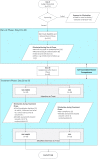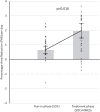A Novel Randomized Trial Protocol for Evaluating Wound Healing Interventions
- PMID: 37526355
- PMCID: PMC10615036
- DOI: 10.1089/wound.2023.0058
A Novel Randomized Trial Protocol for Evaluating Wound Healing Interventions
Abstract
Background: Randomized controlled trials using complete healing as an endpoint suffer from poor statistical power, owing to the heterogeneity of wounds and their healing trajectories. The Food and Drug Administration (FDA) has recently consulted with expert groups to consider percentage area reduction (PAR) of the wound over a 4-week period as a valid intermediate endpoint, creating the opportunity for more powerful study designs. Methods: A within-subject controlled study design comparing the PAR of venous leg ulcers (VLU) in patients over 4 weeks receiving different interventions. Twenty-nine patients received multilayer compression over 4 weeks, followed by neuromuscular electrostimulation (NMES) of the leg muscle pump in addition to compression for a further 4 weeks. Paired comparison was then made of PAR between the two phases. A second cohort of 22 patients received only multilayer compression throughout both 4-week phases. Results: Patients randomized to NMES saw a significant increase in healing rate compared with compression alone, whereas patients receiving compression only saw no significant change in healing rate throughout the course of the study. Conclusions: Intermittent NMES of the common peroneal nerve significantly accelerates the healing of VLU. It is well tolerated by patients and deserves serious consideration as an adjuvant to compression therapy. PAR is a useful metric for comparing the performance of wound healing interventions, and the self-controlled trial design allows sensitive discrimination with a relatively small number of subjects over a reasonably short trial period. The study is reported according to the CONSORT reporting guidelines. Clinical Trial Registration: NCT03396731 (ClinicalTrials.gov).
Keywords: neuromuscular electrostimulation; self-controlled; study design; venous leg ulcers.
Conflict of interest statement
No competing financial interests exist.
Figures




References
-
- Rice JB, Desai U, Cummings AK, et al. Burden of venous leg ulcers in the United States. J Med Econom 2014;17(5):347–356. - PubMed
-
- Neumann HAM, Cornu-Thenard A, Junger M, et al. Evidence-based (S3) guidelines for diagnostics and treatment of venous leg ulcers. J Eur Acad Dermatol Venereol 2016;30:1843–1875. - PubMed
Publication types
MeSH terms
Associated data
LinkOut - more resources
Full Text Sources
Medical
